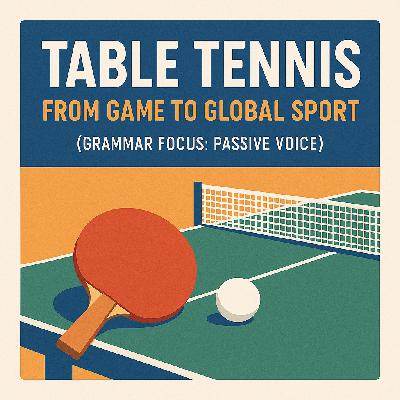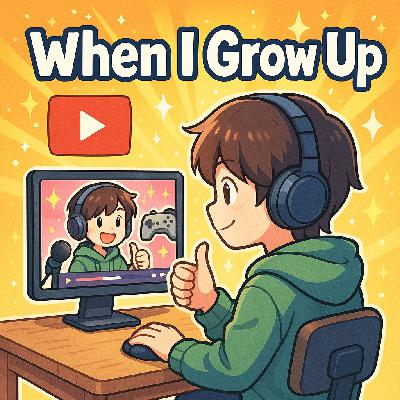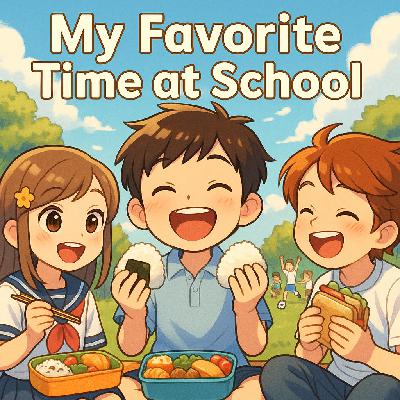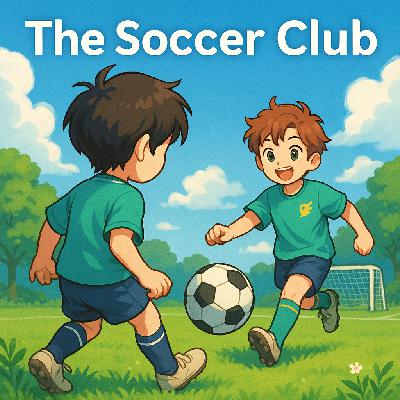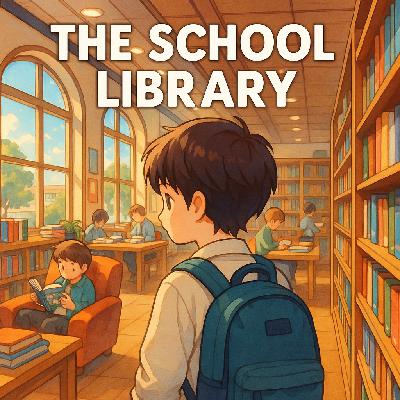Discover 英语背诵短文精选
英语背诵短文精选

40 Episodes
Reverse
英文完整原文 (Full English Text)Table Tennis: From Game to Global SportTable tennis, often known as 'ping-pong', is a fast-paced game that is enjoyed by millions globally. This sport was originally created in England during the late 19th century. It was first seen as a simple distraction for middle-class Victorian society, with champagne corks used as balls and books for the net. The official game of table tennis was later developed using celluloid balls and bats covered in rubber. The name 'ping-pong' itself was inspired by the sound of the ball being struck and bouncing on the table. In the early 20th century, the first world championships were organized. Today, table tennis is recognized as an Olympic sport, having been included since 1988. The sport is now highly competitive, especially in Asia. This journey from a casual parlour game to an intense Olympic event shows how deeply sports are woven into global culture.中文完整译文 (Full Chinese Translation)乒乓球:从游戏到全球性运动乒乓球,常被称为“ping-pong”,是一项快节奏的运动,被全球数百万人所喜爱。这项运动最初于19世纪晚期在英格兰被创造出来。起初,它被视为维多利亚时代中产阶级的一种简单消遣,当时用香槟软木塞做球,用书本做球网。后来,正式的乒乓球运动发展起来,使用赛璐珞球(早期塑料球)和覆盖橡胶的球拍。“乒乓”这个名字本身的灵感来自于球被击打和在桌上弹跳的声音。在20世纪初,第一届世界锦标赛被组织举办。今天,乒乓球被公认为一项奥林匹克运动,自1988年起就被列入其中。这项运动现在竞争非常激烈,特别是在亚洲。这段从休闲的室内游戏到激烈的奥运项目的历程,展示了体育是如何深深地融入全球文化的。关键词讲解 (Key Vocabulary)Fast-paced (形容词): 快节奏的描述运动速度快,变化多。Distraction (名词): 消遣;娱乐;分心文中指供人放松的娱乐活动(entertainment)。Victorian society (名词词组): 维多利亚时代的社会指19世纪英国维多利亚女王统治时期,代表了一种特定的历史背景和阶级文化。Celluloid (名词): 赛璐珞一种早期的塑料材料,以前用来制作乒乓球(现在多用新型塑料)。Inspired by (词组): 受……启发;灵感来源于……Recognized as (词组): 被公认为……;被确认为……Parlour game (名词词组): 客厅游戏;室内游戏Parlour是旧式英语中“客厅/会客室”的意思。指那种非正式的、在家中玩的游戏。Woven into (动词短语 - weave的过去分词): 编织进;融入比喻体育已经成为文化中不可分割的一部分。关键语法讲解 (Key Grammar)这篇文章主要描述事物的历史(History of things),因此大量使用了被动语态 (Passive Voice)。A. 被动语态 (Passive Voice)结构: be (is/are/was/were) + 过去分词 (Past Participle)作者关注的是“乒乓球这项运动”经历了什么,而不是“谁”发明或改变了它(因为发明者可能不明确或不重要)。文中出现的被动语态清单:Is enjoyed (被喜爱)原文:...a game that is enjoyed by millions...解析:一般现在时的被动语态,表示现在的状态。Was created (被创造)原文:This sport was originally created in England...解析:一般过去时的被动语态,描述历史起源。Was seen (被看待/被视为)原文:It was first seen as a simple distraction...解析:描述过去人们对它的看法。Was developed (被发展/改良)原文:The official game... was later developed...解析:描述事物的演变过程。Was inspired (被启发/灵感来自)原文:The name... was inspired by the sound...解析:解释名字的由来。Were organized (被组织/举办)原文:...the first world championships were organized.解析:注意这里用were,因为主语championships是复数。Is recognized (被认可)原文:...table tennis is recognized as an Olympic sport...解析:回到一般现在时,表示目前的地位。Are woven (被编织/融入)原文:...sports are woven into global culture.解析:描述一种普遍的现状。B. 被动语态的高级形式 (Advanced Passive Forms)文中还有两个比较高级的被动结构,稍微提一下作为拓展:Being struck (被动语态的动名词/分词形式)原文:...sound of the ball being struck...含义:球正在被击打的声音。Having been included (现在完成时的被动分词)原文:...having been included since 1988.含义:自1988年以来一直被包含在内。
英文原文LeBron James has been a dominant force in the NBA since he was drafted in 2003. Raised in Akron, Ohio, he has faced many personal challenges, but he has always shown incredible athletic talent. Over his long career, he has played for the Cleveland Cavaliers, the Miami Heat, and the Los Angeles Lakers. James has won four NBA championships and four NBA Finals MVP awards. He has also made history as the NBA’s all-time leading scorer, a monumental achievement that few players have ever dreamed of. Furthermore, he has always used his platform to address social issues and support charitable causes. His impact goes far beyond the court. Recently, he has continued to make headlines, demonstrating remarkable longevity in a physically demanding sport. Fans often wonder how much longer he will play, but for now, we have enjoyed watching one of the best in the game.2. 中文译文自从2003年被选中以来,勒布朗·詹姆斯一直是NBA的一股主宰力量。他在俄亥俄州阿克伦长大,面临过许多个人挑战,但他总是展现出令人难以置信的运动天赋。在他漫长的职业生涯中,他曾效力于克利夫兰骑士队、迈阿密热火队和洛杉矶湖人队。詹姆斯赢得了四次NBA总冠军和四次NBA总决赛最有价值球员(MVP)奖项。他还作为NBA历史得分王创造了历史,这是一个很少有球员敢梦想的丰碑式成就。此外,他总是利用自己的平台来关注社会问题并支持慈善事业。他的影响力远不止于球场。最近,他继续登上头条,在一项对体能要求极高的运动中展现了非凡的职业常青(寿命)。球迷们经常想知道他还会打多久,但就目前而言,我们一直很享受观看这位赛场上最出色的球员之一的表演。关键词讲解 Dominant force (词组): 主宰力量;统治级力量形容某人在某个领域非常强大,具有绝对优势。Monumental (形容词): 丰碑式的;巨大的;不朽的用来形容极其伟大或重要的成就(如成为历史得分王)。Platform (名词): 平台这里引申为公众人物利用其名气发声的机会或渠道。Address social issues (词组): 解决/关注/探讨社会问题Address在此作动词,意为“处理、对付、致辞”。Charitable causes (名词词组): 慈善事业Make headlines (词组): 上头条;成为新闻焦点Longevity (名词): 长寿;(职业生涯的)长久性在体育界,特指运动员在很长一段时间内保持高水平竞技状态的能力。Physically demanding (形容词词组): 对体能要求极高的Demanding意为“苛求的、费力的”。关键语法讲解这篇文章的核心语法是现在完成时 (Present Perfect Tense)。与上一篇乔丹的文章(主要用一般过去时,因为乔丹已退役)不同,詹姆斯目前仍在打球,所以文章侧重于“从过去到现在一直持续的状态”或“过去的动作对现在造成的影响”。A. 现在完成时 (Present Perfect Tense)结构: have / has + 过去分词 (Past Participle)文中大量使用此时态来连接过去和现在:Has been (一直是)原文:LeBron James has been a dominant force... since...解析:表示从2003年至今,他一直保持着统治力。Has played (效力过)原文:...he has played for the Cleveland Cavaliers...解析:总结他职业生涯至今的经历。Has won / Has made (赢得了/创造了)原文:James has won four NBA championships... He has also made history...解析:强调截至目前为止他取得的成就(数字可能会增加)。Has continued (继续)原文:...he has continued to make headlines...解析:表示最近发生的动作,且影响持续到现在。B. 分词短语作状语 (Participial Phrases)文中使用了两种分词短语来简化句子结构,使表达更高级。过去分词 (Raised...) - 表被动或背景原文:Raised in Akron, Ohio, he has faced...解析:相当于 "Because he was raised in Akron..." 或 "Although he was raised..."。这里作为背景信息放在句首。现在分词 (...demonstrating...) - 表伴随或结果原文:...make headlines, demonstrating remarkable longevity...解析:相当于 "...and this demonstrates..."。表示“登上头条”这个动作同时体现了(demonstrating)他的职业常青。
英文完整原文 (Full English Text)Michael Jordan is widely regarded as one of the greatest athletes in history. He was born in New York in 1963, but he was raised in North Carolina. After playing for the University of North Carolina, Jordan was drafted by the Chicago Bulls in 1984. During his career with the Bulls, he led the team to six NBA championships. He was admired by millions of fans all over the world not only for his skill, but also for his dedication. In the 1980s and 1990s, the NBA was successfully popularized around the globe largely because of his influence. Jordan's competitiveness was often shown during games, and his legendary status was cemented when he won five NBA Most Valuable Player (MVP) awards. Even today, long after his retirement, Jordan’s legacy is discussed by basketball fans and analysts. His story teaches us that true greatness is achieved through countless hours of hard work. We are taught by his example to never give up on our dreams. 中文完整译文 (Full Chinese Translation)迈克尔·乔丹被广泛认为是历史上最伟大的运动员之一。他于1963年出生在纽约,但在北卡罗来纳州长大。在为北卡罗来纳大学效力之后,乔丹在1984年被芝加哥公牛队选中。在公牛队的职业生涯中,他带领球队夺得了六次NBA总冠军。他不仅因其球技,更因其敬业精神而受到全世界数百万球迷的崇拜。在20世纪80年代和90年代,NBA之所以能在全球范围内成功普及,很大程度上是因为他的影响力。乔丹的好胜心经常在比赛中显露无疑,而当他赢得五次NBA最有价值球员(MVP)奖项时,他的传奇地位得到了巩固。即使在今天,在他退役很久之后,乔丹留下的传奇遗产(影响力)仍然被篮球迷和分析师们津津乐道。他的故事告诉我们,真正的伟大是通过无数小时的辛勤努力才实现的。他的榜样教导我们永远不要放弃梦想。关键词讲解 (Key Vocabulary)Widely regarded as (词组): 被广泛认为是……用于表达大众普遍的观点或评价。Drafted (动词 - draft的过去分词): 选秀;征召在体育语境中特指“选秀”(如NBA选秀)。Dedication (名词): 奉献;敬业精神指全身心投入某事的态度。Popularized (动词 - popularize的过去分词): 使普及;推广这里指让NBA在全世界变得流行。Competitiveness (名词): 好胜心;竞争力形容乔丹那种极其渴望胜利、不服输的性格。Cemented (动词 - cement的过去分词): 巩固;加强本意是用“水泥”粘合,引申为使某种地位或关系变得不可动摇。Legacy (名词): 遗产;遗留之物常用来指伟人留下的精神财富、影响力或历史功绩。Analysts (名词): 分析师;评论员指对比赛进行专业分析的人。关键语法讲解 (Key Grammar)这篇文章的核心语法点是被动语态 (Passive Voice),几乎每一句都在使用它。A. 被动语态 (Passive Voice)公式: be动词 (is/was/are/were) + 过去分词 (Past Participle)这篇文章主要讲述乔丹的生平,但侧重于“他经历了什么”或“外界如何看待他”,因此大量使用了被动语态。文中的典型例句解析:Is regarded (被认为)原文:Michael Jordan is widely regarded as...解析:强调大家的普遍看法,而不是具体谁认为。Was raised (被抚养长大)原文:...he was raised in North Carolina.解析:强调成长的地点。Was drafted (被选中)原文:...Jordan was drafted by the Chicago Bulls...解析:动作执行者是公牛队 (by the Chicago Bulls)。Was admired (被崇拜)原文:He was admired by millions of fans...解析:动作执行者是数百万粉丝。Was cemented (被巩固)原文:...his legendary status was cemented...解析:强调地位变得稳固这一结果。Is achieved (被实现)原文:...true greatness is achieved through...解析:表达一种普遍的真理:伟大是通过努力得来的。B. Not only... but also... (不仅……而且……)这是非常实用的并列连词结构,用于强调两方面都很重要,且通常侧重于后半部分。原文: "...not only for his skill, but also for his dedication."解析: 作者想表达:虽然他的技术(skill)很棒,但他的敬业精神(dedication)同样甚至更值得钦佩。
● 背景: 这篇短文描述了一次参观历史博物馆的经历,它将语言学习与历史文化主题相结合,旨在激发学生对探索和学习新事物的兴趣。● 核心语言重点: 过去时,thereis/are。● 课文:LastSaturday, my family and I went to a museum. It was a history museum. The museumwas very big. There were many old things from the Edo period. My father wasvery interested. There were old swords, books, and clothes. I saw a picture ofa samurai. He had a big sword. My mother and my brother were looking at someold pots. My brother said they were beautiful. The museum was so quiet. It wasa very good place to learn about the past. My teacher said we should go tomuseums more often.● 词汇亮点:○ museum 博物馆○ history 历史○ Edo period 江户时代○ samurai 武士○ pots 罐子● 语法解析:这篇短文完美地结合了过去时态和there was/were句型。它使用过去时态来叙述一个已完成的事件(went,was, saw),同时通过Therewere many old things...和There were old swords...等句式,详细地描述了博物馆内的展品。
● 背景: 这篇短文为学生提供了一个用英语描述自己家乡或居住地的模板,符合文部科学省鼓励学生通过外语了解文化和地理的教学目标4。● 核心语言重点: there is/are,形容词。● 课文:Myhometown is called Kofu. It is a small city in Yamanashi Prefecture. There aremany mountains around the city. In the summer, it is very hot. But in thewinter, it is cold, and we can see snow on the mountains. There is also a bigriver that runs through the city. I go to the river to ride my bicycle with myfriends. We go to school in the city. There are many people in the city, but itis not too big. I like my hometown very much. I think it is a very peaceful andbeautiful place.● 词汇亮点:○ hometown 家乡○ mountains 山○ river 河○ peaceful 宁静的○ beautiful 美丽的● 语法解析:本文主要通过There are many mountains...和There is also abig river...等句式,练习“there is/are”句型来描述一个地方存在的事物。此外,small,hot, cold, big, peaceful和beautiful等形容词的使用,也让学生能够更生动地描绘自己的家乡。
● 背景: 家庭生活是学生最熟悉也最重要的社会单元。这篇短文通过描述一个家庭的晚餐场景,旨在让学生学习如何用英语描述家庭日常,同时了解不同家庭的习惯。● 核心语言重点: 一般动词,we。● 课文:Myfamily eats dinner together every night. My mother is a very good cook.Tonight, we are having sushi. My father loves sushi. He is a happy man when heeats it. My brother is eating rice and vegetables. He likes vegetables. We talkabout our day at school and work. It is a good time for our family. We talkabout our dreams and our plans. My mother always asks me about my friends. Weare a happy family. We eat dinner and talk for a long time.● 词汇亮点:○ dinner 晚餐○ sushi 寿司○ cook 厨师○ vegetables 蔬菜○ happy 快乐的● 语法解析:文章主要使用一般现在时来描述日常习惯和事实(My family eats..., He loves...),以及现在进行时来描述正在发生的动作(we are having..., My brother is eating...)。此外,短文中的代词we的用法也得到了很好的练习。
● 背景: 这篇短文直接面对学生的学业焦虑,特别是考试失败带来的挫败感。文章通过叙述一个学生如何重新振作的故事,旨在传递积极的心态和应对挑战的方法。● 核心语言重点: 一般动词,过去时。● 课文:Sometimes,I fail a test. It is not a good feeling. But my mother says, "It is okayto fail. It is not the end." My friend, Taro, also failed a math test. Hewas very sad, but he studied very hard. He asked our teacher for help. And hestudied with me. We worked together. He got a good score on the next test! Ithink it is important to try again. I don't give up. I will study harder forthe next test. I want to get a good score, and I want to feel happy.● 词汇亮点:○ fail 失败○ test 考试○ feeling 感觉○ sad 难过○ give up 放弃● 语法解析:本文主要练习一般动词的过去时态,包括规则动词(failed, studied, worked)和不规则动词(got)。通过描述Taro如何从失败中重新站起来,短文为学生提供了过去时态在叙事中的实际应用范例。
● 背景: 这篇短文从一个轻松愉快的角度切入,描述了一双新鞋。它既能让学生练习描述个人物品,也反映了初中生对时尚和个人外貌的关注,这是该年龄段的常见困扰之一。● 核心语言重点: this/that is,形容词。● 课文:Thisis my new pair of sneakers. They are black and white. They are very cool! Ibought them last weekend with my father. They are a little expensive, but theyare very comfortable. My old shoes were too small. My feet are growing fast. Myfriends also have new shoes. Taro's new shoes are red. They are big and fast.They are for playing basketball. I like my new shoes. They are my favoritecolor. I will wear them to school every day.● 词汇亮点:○ sneakers 运动鞋○ comfortable 舒适的○ expensive 昂贵的○ cool 酷的○ growing 成长● 语法解析:本文的重点是使用this和they配合be动词来描述事物(This is my new pair...,They are black andwhite)。同时,通过new、cool、expensive和comfortable等形容词的运用,学生可以掌握如何用英语对物品进行具体描述。
● 背景: 巴士旅行是一个常见的旅行方式,也是学生们在学校和家庭中常有的经历。这篇短文通过叙述一次旅行,旨在让学生练习用过去时态讲述故事,并掌握地点状语的用法。● 核心语言重点: 过去时,地点状语。● 课文:Lastmonth, my class went on a trip. We went to a small town by bus. We sat on theright side of the bus. I sat with my friend, Yuta. We were very excited. Thebus trip was long, but we had fun. We sang songs and talked about our favoritemovies. When we got there, we visited an old building. There was a big gardenbehind the building. The garden was very beautiful. The town was so quiet andclean. I was very happy to be there. I took a lot of pictures with my phone. Itwas a good trip.● 词汇亮点:○ trip 旅行○ bus 公共汽车○ excited 兴奋的○ building 建筑物○ pictures 照片● 语法解析:本文主要使用过去时态来描述一次完整的旅行经历(went, sat, were, had, sang, talked, took)。同时,文章还运用了多种地点状语,如onthe right side of the bus,behind the building,帮助学生学习如何描述位置和方位。
● 背景: 面对“学业”、“升学”和“未来”等问题时,初中生普遍感到焦虑。这篇短文以第一人称的独白形式,真诚地探讨了未来的职业梦想,旨在与学生们建立情感连接,并练习将来时态的表达。● 核心语言重点: 将来时表达。● 课文:WhenI grow up, I want to be a YouTuber. I am thinking about this a lot. I likewatching videos, and I want to make them for people. I will make videos aboutvideo games, and I will talk about new games. I think many people will watch myvideos. My friend, Riki, wants to be a professional soccer player. He ispracticing a lot. It is a good dream. My father wants me to be a teacher, but Ithink a YouTuber is a good job. I think I will be happy if I am a YouTuber. Iwill try to work hard to make my dream come true.● 词汇亮点:○ future 未来○ YouTuber 视频博主○ professional 专业的○ dream 梦想○ hard 努力地● 语法解析:本文主要练习了两种将来时态的表达方式:will 和 be going to。例如,I will make videos... 和 I think many peoplewill watch... 用于表达对未来的预测或意愿。同时,Myfriend, Riki, wants to be... 句型也提供了练习表达愿望的另一种方式。
● 背景: 运动会是日本学校年度最重要的活动之一。这篇短文以日记的形式,让学生通过叙述比赛过程和感受,练习过去时态的运用和形容词的修饰。● 核心语言重点: 过去时,形容词。● 课文:LastFriday was Sports Day at our school. It was a very hot day. My class was the"Blue Team." The "Red Team" was also very good. We ran inthe race, and we played soccer. I ran in the relay race. I was very fast. Myfriends were cheering for me. In the afternoon, we had a tug-of-war. My teamwas very strong. We won! We were so happy. It was a wonderful day. Our teachersaid we were a very good team. My friends and I were so tired but so happy.● 词汇亮点:○ Sports Day 运动会○ race 赛跑○ cheering 欢呼○ tug-of-war 拔河○ tired 累的● 语法解析:本课文主要使用一般过去时来描述已发生的事件和状态。例如,“Last Friday was Sports Day”和“We ran in the race...”。同时,短文中运用了大量的形容词来描述感受和状态,如hot,good,fast,strong,happy和tired,帮助学生丰富口语和写作的表达。
● 背景: 午餐时间是学生一天中重要的社交和放松时刻。这篇短文以这一日常情境为背景,旨在让学生练习描述日常行为和感受,同时学习与食物相关的词汇。● 核心语言重点: 一般动词,过去时。● 课文:Myfavorite time at school is lunchtime. I eat my lunch with my friends. Today, Ihave rice balls and some fried chicken. My friend, Hanako, has a bento box withmany colors. She is a good cook. My friend, Yuta, has a sandwich. We talk aboutour classes and our weekend plans. We laugh and have a good time. Sometimes wetalk about the new video games. After we finish eating, we go outside and play.The other students are playing games too. We eat lunch very fast because wewant to play for a long time.● 词汇亮点:○ favorite 最喜欢的○ lunchtime 午餐时间○ rice balls 饭团○ bento box 便当盒○ sandwich 三明治● 语法解析:文章主要使用一般现在时来描述日常习惯(I eat my lunch,We talk about...)5。结尾的“We eat lunch very fast...”则通过简单的对比,强化了学习者对时间安排和个人习惯的表达。
● 背景: 校内体育俱乐部在日本中学生活中扮演着核心角色9。本短文以足球俱乐部为例,描绘了学生在社团活动中如何通过努力和团队合作实现目标,并练习情态动词can和动名词的用法。● 核心语言重点: can,动名词。● 课文:I ama member of the soccer club. Our team is the "Green Eagles." Wepractice every day after school. We run a lot, and we practice kicking theball. I can run very fast, but I can't kick the ball very well. My friend,Masao, is very good. He is the best player on the team. He can kick the ballfar, and he can score many goals. I want to be like him. The club is a lot offun. I am happy when I am with my friends. We all work hard to be a good team.Our team is like a family.● 词汇亮点:○ member 成员○ soccer club 足球俱乐部○ practice 练习○ kick 踢○ score 进球语法解析:本课文的核心语法点是情态动词can及其否定形式can't,用于表达能力。例如,“I can runvery fast” 和“I can't kick the ball very well”。此外,文章还展示了动词practice后接动名词kicking的用法,以及动名词在句子中作为宾语的用法。
● 背景: 针对学生对有趣、互动性强课堂的渴望10。这篇文章通过描述一堂生动的科学课,旨在鼓励学生积极参与课堂活动,并练习用过去时态来讲述经历。● 核心语言重点: 一般动词,过去时。● 课文:Yesterday,my science class was very interesting. My teacher, Mr. Tanaka, taught us aboutrobots. He showed us a cool video about a small robot. The robot can walk anddance. It can also talk. I want to build a robot like that. We also did anexperiment. We made a small robot hand. It was very fun. I asked Mr. Tanaka alot of questions. He was happy to answer. The class was so fun. I didn't wantit to end. My friend Akira also liked the class. We want to do more experimentssoon.● 词汇亮点:○ interesting 有趣的○ robot 机器人○ video 视频○ experiment 实验○ questions 问题● 语法解析:本课文是练习一般过去时的绝佳材料。句子“My teacher...taught us...”和“We also did an experiment”使用了过去式来叙述一堂课的事件。学生可以通过模仿这些句式,学习如何用英语讲述过去发生的经历。
● 背景: 描述一个安静、适合学习的场所,这与部分学生的学习偏好相契合。通过参观图书馆的经历,短文旨在让学生学习描述场所和物件,并练习“There is/are”句型。● 核心语言重点: 过去时,thereis/are。● 课文:Yesterday,I went to the school library. It is a very big library. There were a lot of newbooks about science and history. There was also a new table near the window. Itwas a good place to study. I saw many students there. Some students werestudying for a test. My friend, Hiroshi, was reading a comic book. He wassitting on a big, soft chair. I looked for a book about space. I found a bookwith a lot of beautiful pictures of stars and planets. There were also manybooks about science. The library is a great place.● 词汇亮点:○ library 图书馆○ science 科学○ history 历史○ study 学习○ planet 行星语法解析:本课文的语法核心是过去式(went, saw, looked)和there was/were句型。句子“Therewere a lot of new books...”和“There was also a new table...”是学习如何在过去时态中描述存在事物的最佳范例。
● 背景: 本文直接回应了日本初中一年级学生最普遍的困扰之一——学业压力和对学习方法的困惑。通过描述一个学生面对作业难题的真实感受,旨在让学生感到被理解,并练习如何用英语表达自己的困境。● 核心语言重点: 一般动词,否定句。● 课文:Ihave a lot of homework tonight. I have math, science, and English homework. Mymath homework is very difficult. I don't understand it. I need to ask myteacher tomorrow. My friend Kenji is very good at math. Maybe I can ask him forhelp. He always helps me when I have a problem. My English homework is easy. Ijust need to write about my family. That is not difficult. But my sciencehomework is also hard. I don't understand the questions. So, I will do myEnglish homework first. Then I will try to do the rest.● 词汇亮点:○ homework 作业○ difficult 困难的○ understand 理解○ teacher 老师○ problem 问题● 语法解析:这篇课文主要练习了否定句的构成,特别是“don't + 动词”的用法(Idon't understand it)。通过将否定句嵌入到描述学生困境的语境中,学生可以自然地掌握如何用英语表达“我不会”或“我不理解”。
● 背景: 宠物是学生们重要的家庭成员,也是他们日常生活中常见的话题。这篇短文通过描述与宠物的互动,让学生能够轻松地用英语表达自己的情感,并学习基本的名词和动词。● 核心语言重点: 一般动词,所有格代词。● 课文:Ihave a pet. It is a cat, and his name is Leo. He is three years old. He is asmall cat, but he is very fast. I play with him every day. I throw a smallball, and he runs and gets it. He does not like to be alone. He likes to sleepon my bed. At night, he sleeps with me. He is my best friend. He is a very goodpet. My friends also have pets. Taro has two dogs, and Hana has a small rabbit.Her rabbit is very quiet. My cat is not quiet! He meows a lot when he ishungry.● 词汇亮点:○ pet 宠物○ cat 猫○ throw 扔○ sleep 睡觉○ quiet 安静的语法解析:这篇短文主要使用了现在时来描述日常习惯和事实(I have a pet, He likes to sleep)。它还重点练习了所有格代词my和his,帮助学生清晰地表达物品或宠物的所有关系。
● 背景: 这篇短文围绕“周末计划”这一普遍话题展开,旨在让学生用简单的语言来描述过去和未来的活动,并练习如何提出和回答问题。● 核心语言重点: 过去时,be动词,疑问句。● 课文:Myfriends and I have a plan for this weekend. On Saturday, we are going to themall. There is a new video game store there. We want to look at the new games.After that, we are going to get ice cream. On Sunday, we are going to playbasketball in the park. Last weekend, we went to the beach. We played in thewater, and we ate lunch on the sand. My friends and I had a good time. Whatabout you? What are you going to do this weekend?● 词汇亮点:○ weekend 周末○ plan 计划○ mall 购物中心○ store 商店○ beach 海滩语法解析:这篇短文综合练习了多种时态。它使用将来时(are going to the mall)来描述即将发生的计划,也使用了过去时(we went to the beach,weate lunch)来回顾上一个周末的经历。此外,短文末尾的疑问句“What are you going to do...?”则为学生提供了提出未来计划相关问题的模板。
● 背景: 随着数字工具的普及,在线绘画和插画已成为学生的新兴爱好之一。这篇短文通过描述一个学生的绘画经历,将语言学习与创造性活动相结合,同时引入情态动词can来表达能力。● 核心语言重点: can,动名词。● 课文:I candraw on my tablet. This is my new hobby. I have a pen for the tablet, and I candraw many things with it. Last year, I could not draw well, but now I can drawpeople and animals. I love drawing comic book characters. My art teacher isteaching us. She says my drawings are better now. Drawing is a lot of fun. Ican draw a picture in 10 minutes. I practice drawing after school every day. Myfriend Tsubasa also likes drawing. We like drawing together. Drawing on thetablet is easy and fun.● 词汇亮点:○ tablet 平板电脑○ hobby 爱好○ characters 角色○ teacher 老师○ practice 练习● 语法解析:本课文重点在于情态动词can的用法,如“I can draw on my tablet”和“I can draw people and animals”,用于表达能力。同时,文章还巧妙地引入了动名词(drawing)作为句子的主语(“Drawing is a lot offun.”)或动词的宾语(“I love drawing...”),帮助学生理解动名词作为名词的语法功能。
● 背景: 该短文以视频观看为主题,这是继游戏之后,初中生第二大流行爱好7。通过描述一个学生观看视频时的实时动作,文章旨在将现在进行时的抽象概念,融入到学生熟悉的具体情境中。● 核心语言重点: 现在进行时,be动词。● 课文:I amwatching a video now. It is a video about a new kind of robot. The robot isvery small, and it can fly. The man in the video is showing the robot toeveryone. He is talking about the robot’s special powers. He is also flying therobot inside his house. My little brother is sitting next to me. He is watchingthe robot too. He is very excited. He is asking a lot of questions. I am tryingto listen, but he is talking too much! After this video, I want to watch avideo about a famous musician. My brother doesn't like that, but I love music.● 词汇亮点:○ watching 正在看○ robot 机器人○ excited 兴奋的○ musician 音乐家○ listen 听语法解析:本课文是学习现在进行时(am/is/are + verb-ing)的绝佳范例。句子“I am watchinga video”和“He is talking about...”清楚地描述了正在发生的动作5。同时,短文也巩固了be动词(如 It is a video)在陈述句中的用法,为学生提供了将不同时态融会贯通的练习机会。



